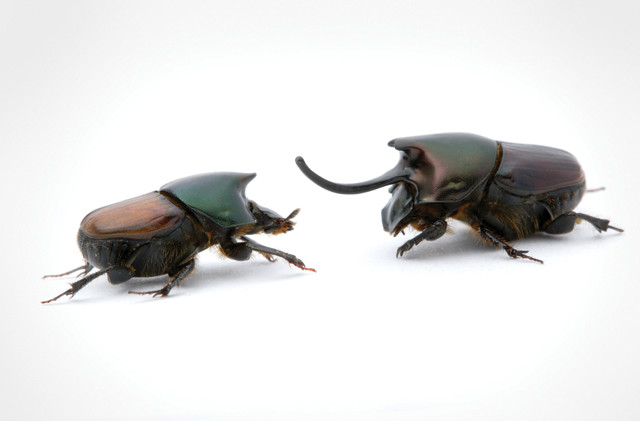
by Lucas Joel Wednesday, March 29, 2017

New research provides an explanation for the bimodality in male ornamentation seen in some animal species, such as in male dung beetles, which can either have large horns or no horn at all. Credit: Alex Wild.
The showy features of male animals are often advantageous for attracting mates. Yet these same traits can also prove harmful: A peacock’s long, many-eyed feathers — great for enticing females — can get in the way if a predator gives chase, and a red deer’s elaborate antlers can become stuck in branches, potentially trapping the animal. In a new study, researchers report that a distinctive bimodality in male ornamentation occurs in some species, suggesting that when it comes to successfully courting females, it pays for males to either have the flashiest, most elaborate ornaments, or no such parts at all.
ne example of this “bimodal” ornament distribution is found in dung beetles. “Some fraction end up with very large horns and some with very small horns,” says Daniel Abrams, a mathematician at Northwestern University and a co-author of the new study in Proceedings of the Royal Society B. Animals like dung beetles “can be flashy, with the benefit that they attract more mates, but at the cost that they may live shorter lives,” adds Sara Clifton, a doctoral student at Northwestern and lead author of the study. Alternatively, she says, animal ornamentation “can be subdued, which means they’ll likely attract fewer mates in the short run, but may live long enough to have more offspring total.”
ut whether such stark bimodality is predictable — or to be expected — in any given species has not been clear. So, Clifton, Abrams and their colleagues devised a mathematical model that mimics species evolution over several generations, and tracks how a species’ fitness changes with ornament size over time. The researchers found that ornamentation should be bimodally distributed regardless of species. “The model is special because it does not rely on a specific mechanism, mating behavior, or species to have this explanatory or predictive power,” Clifton says.
he researchers then compared their model to observations of male ornamentation in 15 different animal species, such as dung beetles, red deer and lions — whose manes vary in color and length. While many of the ornament datasets available for the animals selected were too small to offer a clear indication, Clifton says, in six cases “we were able to definitively say that these ornaments’ sizes were bimodally distributed.”
or red deer, “no matter what we assumed in the details of the mathematical model, it’s a very robust prediction that you get two types emerging — the showy, or flashy, type with the big antlers, and the subdued type with smaller antlers, and both of those will do okay,” Abrams says. But “it’s bad to be in between,” he adds.
he tradeoff is between spending the energy necessary to produce and maintain elaborate ornamentation to stand out, or producing little to no ornamentation and investing the saved energy in, for example, maintaining functioning reproductive organs, explains Armin Moczek, an evolutionary biologist at Indiana University who was not involved in the new work. The latter, Moczek adds, may give unornamented animals an edge over their more showy peers.
ne gray area in the work involves deciding what is, and is not, an ornament. Male dung beetles, for example, use their horns for fighting other males, so it is not entirely clear whether the horns are weapons, ornaments or both, Clifton says.
aking such distinctions is important, Moczek says. “It surprised me that the number one example in this paper is these beetle horns,” Moczek says. “There’s ample evidence already published for this [animal] that says: (a) these horns are weapons — males beat the heck out of each other, and (b) females don’t choose males based on horn length,” as the beetles spend much of their time underground in complete darkness where they can’t see enough to differentiate males based on horns. For that reason, he says, this research would benefit from “a broad survey of the degree to which … sexual traits function solely as weapons, or solely as ornaments, or both.”
© 2008-2021. All rights reserved. Any copying, redistribution or retransmission of any of the contents of this service without the expressed written permission of the American Geosciences Institute is expressly prohibited. Click here for all copyright requests.